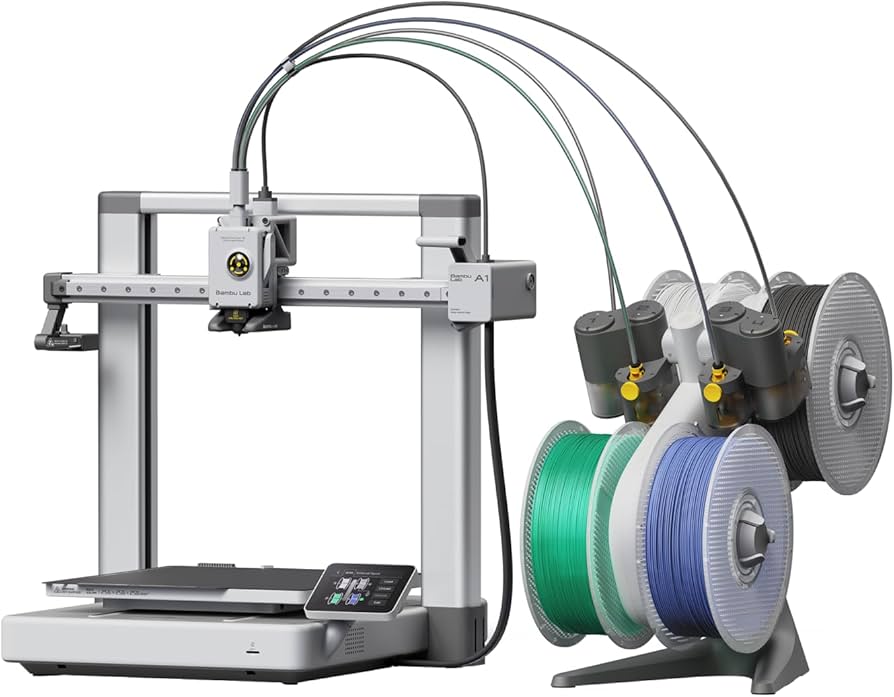Compare Comgrow T300 vs A1
Comparison between the best 3D printers
Choose the best 3D printer at the best price. The cheapest 3D printers are here.
Buy a 3D printer here with 3D Fila.
 |
 |
|
| Model | Comgrow T300 |
A1[BUY A1] |
| Printing Material | Filament | Filament |
| Buy Filament for Sovol Comgrow T300 | Buy Filament forBambu Lab A1 | |
| Estimated price | $449,00 | $700,00 |
| Manufacturer | Sovol | Bambu Lab |
| Release Year | 2024 | 2023 |
| Print Volume [mm] | 300x300x350 | 256x256x256 |
| Printer Size [mm] | 503x631x831 | 385x410x430 |
| Weight [kg] | 17 | 8,3 |
| Power Loss Recovery | YES | YES |
| Enclosed printer | NO | NO |
| Bed Leveling | Automatic | Automatic |
| Filament End Sensor | YES | YES |
| Bed type | Heated | Heated |
| Power supply system | Direct Drive | Direct Drive |
| Standard nozzle | 0,4 | 0,4 |
| Maximum Nozzle Temperature [°C] | 300 | 300 |
| Maximum Bed Temperature [°C] | 100 | 100 |
| Maximum printing speed [mm/s] | 600 | 500 |
| Filament holder | YES | YES |
| Camera for supervision | NO | NO |
| Recommended filaments | PLA, PETG, PET, TPU, PA, ASA, PC, PLA CE, PA-CF, PET-CF | PLA, PETG, TPU, PVA |
| Recommended slicers | Bambu Studio, Super Slicer, Cura, Prusa Slicer, Orca Slicer | SuperSlicer, PrusaSlicer, Cura, OrcaSlicer |
| Maximum Resolution [mm] | 0,1 | 0,1 |
| Processor | 64 bit | |
| Display | Touchscreen 5'' | Touchscreen 3,5 |
| Power Supply | 150 W | 350 W |
| Connectivity | USB, WiFi | Wi-Fi, Bambu-Bus, Cartão Micro SD |
| Operating systems | Windows, Linux, Macbook | Windows, Linux, Macbook |
| Date of registration in the system | 2024-05-10 | 2024-07-17 |
| Release date | 2024 | 2023 |
| Extra features | The Sovol Comgrow T300 printer stands out for its technological innovations and advanced features. With a print size of 300mm300mm350mm, the T300 offers true linear rails on all axes, ensuring greater stability. Its Klipper-based intelligent core and 64-bit microcomputer increase printing speed and quality through pressure advancement and input shaping. The extruder with a gear ratio of 6.5:1 allows for more precise material control, optimizing the printing of flexible materials. In addition, the T300 features a rapid filament cooling system with a high-speed fan and a circular duct piece that improves cooling efficiency. With a 4.3-inch high-refresh rate touchscreen and an 81-point automatic leveling system, the T300 simplifies the preparation and execution of 3D prints. | The BambuLab A1 printer features fully automatic calibration, multi-color printing with the AMS system, active flow rate compensation, quick nozzle change with a clip, active motor noise cancellation, a build volume of 256x256x256 mm³, a maximum extruder temperature of 300°C, and a heated bed of up to 100°C. In addition, it has high precision, a machine health management system and an intuitive 3.5-inch touchscreen interface. |
| Support for multiple colors and materials (AMS and CFS) | NO | YES |
Notes * |
||
| Cost-benefit | 8 / 10 | 7 / 10 |
| Hardware | 3.6 / 10 | 4.8 / 10 |
| Tela | . | . |
| Print volume | 4 / 10 | 4 / 10 |
| Performance | 5 / 10 | 4 / 10 |
| [BUY A1] |
Conclusion |
| In conclusion, both the Comgrow T300 and the Bambu Lab A1 are impressive 3D printers that cater to different user needs and preferences. The Comgrow T300 stands out with its larger print volume and advanced technological features, such as the Klipper-based intelligent core, true linear rails, and an improved cooling system. These features contribute to higher print quality and speed, especially when dealing with flexible materials. Additionally, it offers a more extensive range of recommended filaments, making it versatile for various projects. However, potential users should consider its heavier weight and lack of support for multi-color printing. On the other hand, the Bambu Lab A1's strengths lie in its ease of use and modern features like fully automatic calibration and support for multi-color printing through the AMS system. It has a more compact size and lighter weight, making it an attractive option for those with limited space or those who prioritize portability. While it has a slightly smaller print volume, its overall performance and accuracy remain commendable. When evaluating cost, the Comgrow T300 offers a more budget-friendly solution, while the Bambu Lab A1 provides advanced functionalities typically found in higher-end models. Ultimately, the choice between the two should be guided by your specific printing requirements and budget constraints, with both offering a solid balance of performance and features. |

